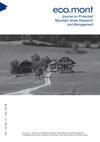Ancient larch trees in the Tuva Republic, land of the oldest trees in Russia
IF 0.8
4区 环境科学与生态学
Q4 BIODIVERSITY CONSERVATION
Eco Mont-Journal on Protected Mountain Areas Research
Pub Date : 2023-01-01
DOI:10.1553/eco.mont-15-2s13
引用次数: 0
Abstract
The ancient trees in the Tuva Republic have both cultural and scientific significance. Our study provides a synthesis of the results of the dendrochronological research carried out by the Siberian Dendrochronological Laboratory over the past 16 years in the Tuva Republic, Russian Federation. By applying state-of-the-art dendrochronological analysis, we identified the oldest dead larch tree ( Larix sibirica Ldb.) in the study region, which had reached 1,307 years old. Living larch trees from the forest-steppe zone (1,000–1,500 m asl) and at the upper treeline (2,000 m asl) are known to have reached 779 and 662 years respectively. Such old trees are of great interest for the scientific community and society. Old living larch trees have witnessed the rise and fall of great nomadic civilizations and agricultural changes. Their identification and protection increase their attraction for tourists and enrich the cultural significance of the region. Until now, however, these trees have remained unprotected and are not registered in international and national registers of long-living trees. In this study, we aim to raise awareness of the need to develop forest protection policies and to preserve ancient living larch trees in the Tuva Republic. Abstract The ancient trees in the Tuva Republic have both cultural and scientific significance. Our study provides a synthesis of the results of the dendrochronological research carried out by the Siberian Dendrochronological Laboratory over the past 16 years in the Tuva Republic, Russian Federation. By applying state-of-the-art dendrochronological analysis, we identified the oldest dead larch tree ( Larix sibirica Ldb.) in the study region, which had reached 1,307 years old. Living larch trees from the forest-steppe zone (1,000–1,500 m asl) and at the upper treeline (2,000 m asl) are known to have reached 779 and 662 years respectively. Such old trees are of great interest for the scientific community and society. Old living larch trees have witnessed the rise and fall of great nomadic civilizations and agricultural changes. Their identification and protection increase their attraction for tourists and enrich the cultural significance of the region. Until now, however, these trees have remained unprotected and are not registered in international and national registers of long-living trees. In this study, we aim to raise awareness of the need to develop forest protection policies and to preserve ancient living larch trees in the Tuva Republic.图瓦共和国的古老落叶松,俄罗斯最古老的树木
图瓦共和国的古树既有文化意义,也有科学意义。我们的研究综合了西伯利亚树木年代学实验室过去16年来在俄罗斯联邦图瓦共和国进行的树木年代学研究的结果。通过最先进的树木年表分析,我们确定了研究区域最古老的落叶松(Larix sibirica Ldb.),年龄为1,307岁。在森林草原地带(海拔高度1000 - 1500米)和林木线上游(海拔高度2000米)的落叶松活树龄分别达到779年和662年。这样的老树引起了科学界和社会的极大兴趣。古老的落叶松见证了伟大游牧文明的兴衰和农业的变迁。它们的识别和保护增加了它们对游客的吸引力,丰富了该地区的文化意义。然而,到目前为止,这些树木仍然没有受到保护,也没有在国际和国家长寿树木登记册中登记。在这项研究中,我们的目标是提高人们对制定森林保护政策和保护图瓦共和国古老落叶松的必要性的认识。图瓦共和国的古树既有文化意义,也有科学意义。我们的研究综合了西伯利亚树木年代学实验室过去16年来在俄罗斯联邦图瓦共和国进行的树木年代学研究的结果。通过最先进的树木年表分析,我们确定了研究区域最古老的落叶松(Larix sibirica Ldb.),年龄为1,307岁。在森林草原地带(海拔高度1000 - 1500米)和林木线上游(海拔高度2000米)的落叶松活树龄分别达到779年和662年。这样的老树引起了科学界和社会的极大兴趣。古老的落叶松见证了伟大游牧文明的兴衰和农业的变迁。它们的识别和保护增加了它们对游客的吸引力,丰富了该地区的文化意义。然而,到目前为止,这些树木仍然没有受到保护,也没有在国际和国家长寿树木登记册中登记。在这项研究中,我们的目标是提高人们对制定森林保护政策和保护图瓦共和国古老落叶松的必要性的认识。
本文章由计算机程序翻译,如有差异,请以英文原文为准。
求助全文
约1分钟内获得全文
求助全文
来源期刊

Eco Mont-Journal on Protected Mountain Areas Research
BIODIVERSITY CONSERVATION-ECOLOGY
CiteScore
1.20
自引率
0.00%
发文量
1
审稿时长
>12 weeks
期刊介绍:
eco.mont offers a platform specifically for scientists and practitioners working in and on protected mountain areas in Europe and overseas.Target audiences of the journal are scientists from all related disciplines, managers of protected areas and an interested public including practitioners, visitors, teachers, etc.
 求助内容:
求助内容: 应助结果提醒方式:
应助结果提醒方式:


